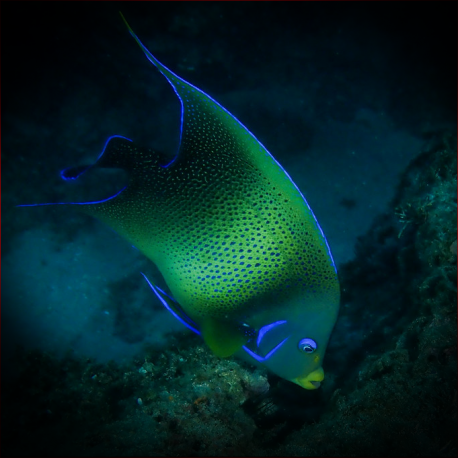More info
Datasheet
| Minimum Tank Size | 700 litres / 184.92 US gallons |
| Maximum Size | 40.0cm / 15.75inches |
| Reef Compatible | Not reef safe |
| Temperament | Aggressive towards other species |
| Temperature | 22.2°C / 71.96°F - 25.6°C / 78.08°F |
| Specific Gravity | 1.020-1.025 |
| Carbonate Hardness | 8-12 |
| pH | 8.1-8.4 |
General Description
The Semicircle angelfish (Pomacanthus semicirculatus) belongs to the Pomacanthus genus of Angelfish, known for their impressive colors and patterns. These fish primarily feed on sponges, soft corals, tunicates, and macroalgae in their natural habitat. There is a significant difference in appearance between juvenile and adult Semicircle angelfish, with proper feeding enabling rapid growth. They can be challenging to acclimate in captivity due to their reluctance to catch their own food initially.
Aquarium Suitability
Semicircle angelfish are considered suitable for aquariums with proper care due to their demanding nature. They require high water quality, including well-oxygenated water, and frequent feeding multiple times a day. These angelfish are not reef-safe, but selective coral choices can allow for their presence in a coral aquarium. They can be aggressive towards other fish, especially in smaller tanks, and caution is advised when housing them with less assertive species.
Demands, Care, and Hardiness
With an average hardiness level, Semicircle angelfish require a minimum tank size of 700 liters. They acclimatize best when introduced as juveniles and benefit from a varied diet and ample space for swimming. These fish can be initially shy in new aquariums and may refuse to eat for about a week. Maintaining a well-established aquarium with algae-rich rocks is beneficial for their well-being.
Reef Suitability
Not reef-safe, Semicircle angelfish can pose a threat to corals, especially soft corals and LPS. Selecting appropriate coral species such as Hammer corals, Bubble corals, Star polyps, and Disc anemones can help mitigate aggression towards corals.
Aquarium Setup
When keeping Semicircle angelfish, providing hiding places among live rocks is essential. A well-maintained aquarium with sufficient algae growth on rocks allows them to graze naturally. It is advisable to supplement their diet with algae-rich foods such as nori seaweed and spirulina.
Behaviour
These angelfish can exhibit aggressive behavior towards other fish and may make grunting sounds when threatened. They can change gender from female to male, and when kept in pairs, simultaneous introduction is recommended.
Feeding and Diet
Semicircle angelfish are effective algae-eaters and should be fed a diet consisting of larger crustaceans, macroalgae, microalgae, other invertebrates, and sponges. Regular feeding several times a day is necessary, especially during the acclimatization period.
Dimorphism and Captive Reproduction
Semicircle angelfish can be bred in captivity, with captive-bred specimens being available. They may form pairs if introduced simultaneously and require attentive care during breeding.
Habitat and Distribution
These angelfish are found in the Indo-West Pacific region, ranging from the Red Sea and East Africa to Samoa, with their habitat extending from southern Japan to Western Australia. Their distribution includes areas such as Indonesia, the East Indian Ocean, and the West Pacific.

